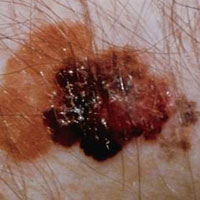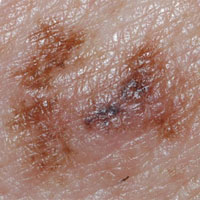Approximately 30% of melanoma (malignant melanoma) cases are associated with existing moles (brown spots). The rest of the cases occur in normal skin, with the sudden formation of new mole.
In men, melanoma most commonly occurs on the chest and the back but in women it also occurs frequently on the legs.
Change in color, shape and size of a new or old mole requires further examination by a physician.
When melanoma is thicker than 1 mm, there is an increased risk of it spreading to other parts of the body. Depending on how thick the melanoma is and how much the cancer has spread, melanoma is divided and classed into several stages. The division stage is important to the treatment plan.
97% of patients with thin melanoma – ie. less than 0.75 mm – and without wounds live more than 5 years. If melanoma is more than 4 mm thick, about 50% live 5 years or more. If melanoma has spread to lymph nodes, prognosis depends on the number of nodes, and the survival rate ranges from 18 to 50%.
See more examples of melanoma below.























the scalp





















